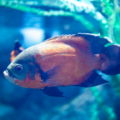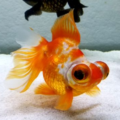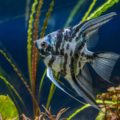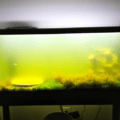Protect your Albino Angelfish from predators and harmful environments by adopting these healthy care practices.

Discovering the Albino Angelfish
Welcome to a deep dive into the life of a special freshwater angelfish — the Albino Angelfish. It’s a distinctive fish species with a snow-white body, delicate fins, and piercing red eyes that leave a lasting impression on you.
Because of its unique physical features, this rare aquarium fish demands careful attention in its living conditions, from the lighting to the diet, health care, and tankmates to ensure its well-being.
Keep reading if you want to understand the allure of the ethereal Albino Angelfish. This guide analyzes its unique care considerations and why many Aquarium enthusiasts love it.
Origins and Genetic Background
The origins of albino fish are surprisingly natural and not a result of careful selective breeding. This species was born in the wild due to an interesting genetic mutation that affects melanin production in the fish, causing its external coloration to appear pale.
Albinism, as a genetic mutation in fish, affects all pigmentation in your fish, from the skin to the eye color and other unique features. That’s why they have pale yellow, almost white skin and bright red eyes.
These albino genetics transfer from parents to their offspring, so if you want to breed Albino Angelfish, you must find two parents with recessive genes, which makes this variant a rarity.
Explaining the albino fish heritage was necessary so you can appreciate its unique care needs and the importance of preserving its pale, sensitive physical characteristics.
Unique Physical Characteristics

The Albino Angelfish appearance is one of the first things that draws your attention to this freshwater fish. It has translucent scales that looks almost transparent to the point of showing its internal organs.
Their eyes typically appear red but can be pink due to the visibility of blood vessels, a common trait in albino fish. These interesting physical traits earned them the nickname pigment-free fish.
So, the next time you’re in the market for an Albino Angelfish and the vendor offers you pigment-free fish, don’t get confused. They’re the same.
As beautiful as its striking appearance is, this fish comes with challenges, such as:
- Hypervisibility to predators due to their lack of pigmentation.
- Hypersensitive scales and eyes because of their condition.
- Dietary struggles due to difficulty in absorbing nutrients.
Overall, these unique albino fish traits make them both captivating and fragile, requiring specialized care to thrive. I’ll share some useful tips on managing health risks for your Albino Angelfish soon, but first, look at these care requirements.
Specialized Care Requirements
Caring for Albino Angelfish requires precise actions to accommodate their sensitivity to light and potential health issues. To avoid those potential health complications, follow these specialized care requirements:
Lighting
Use low to moderate lighting with about 1-2 watts per gallon in your tank. You can also use filtered or diffused light to reduce the intensity and place the bulbs behind a plant to prevent direct sunlight that can burn through the skin.
Water Quality
Maintain pH levels between 6.5-7.5 and keep temperature at 78-82°F. The best way to ensure these optimal aquarium conditions is by testing for ammonia, nitrite, and nitrate levels and immediately adjusting the parameters.
Tank Conditions
Your tank should have enough hiding places for when your Albino Angelfish feels like hiding while holding at least 20 gallons of water for a single Albino Angelfish.
Combining these special habitat requirements and a balanced diet is important for maintaining fish health.
Ideal Habitat Setup
To create a stress-free fish environment and suitable habitat for Albino Angelfish, follow these recommendations for tank size, filtration, and decorations:
Tank Size and Design
I recommend a minimum tank size of 20 gallons for the first fish, with 10 gallons for each additional fish. Use a tall tank design to allow for enough space to swim upwards-downwards, and secure it with a lid to prevent your pets from jumping out.
Filtration
Ensure you use a high-quality yet gentle filtration system with an adjustable flow rate to prevent strong currents. Filtration is a non-negotiable feature in the aquarium setup for sensitive fish because it helps keep the water clean and protect their skin and eyes from infection.
Decorations and Shelter
The suitable habitat for albino fish has enough hiding places and visual barriers like plants and rocks to give this species a chance against predators. Also, avoid sharp or abrasive decorations that may cause injury to your fish’s scales.
Note that these habitat setup tips work with the care requirements, and you can’t ignore one for the other. Now, let’s discuss the ideal nutritional needs and diets for your Albino Angelfish.
Nutritional Needs and Diet

Wondering what you can feed this sensitive fish? Let’s review some dietary requirements for albino fish to ensure they receive a balanced diet.
Your Albino Angelfish diet should consist of high-quality, nutrient-rich foods like protein, carbohydrates, and fiber. Also, add foods rich in omega-3 fatty acids as they provide a nutritious diet for sensitive fish.
Examples include:
- High-quality commercial flakes or pellets are the main staples
- Live or frozen foods like brine shrimp and bloodworms
- Vegetable-based foods like zucchini, blanched peeled peas, and algae matter.
For more on feeding your aquatic pets check out The Ultimate Guide to Fish Food: Pros and Cons & Best Choices!
Feeding Frequency
Even though you’re feeding albino angelfish with a balanced diet, you must portion their food to avoid overfeeding and food-related health diseases.
Feeding 2 – 3 times daily is adequate for your Albino Angelfish, but also ensure it’s a portion they can consume between 2 – 3 minutes. Short feeding times and portion control reduce leftovers that can contaminate your aquarium water and cause harmful bacterial growth.
By following these guidelines, you can guarantee optimal feeding for albino angelfish. Providing your Albino Angelfish with a balanced and nutritious diet supports their unique physical makeup and promotes optimal health.
But where there are genetic complications or indigestion issues, it’s time for treatment.
Health Monitoring and Disease Prevention
The Albino health is fragile due to its sensitive skin, fins, and eyes, so I’ve provided you tips on how you can monitor the health and ensure disease prevention for your fish.
Monitor Water Parameters
Ensure you monitor the water parameters and make necessary adjustments. Also, observe fish for changes in behavior, appetite, or appearance because specific health monitoring helps you spot potential health issues early.
Monitor Behavioral Changes
Look out for signs of discomfort, labored breathing, lethargy, or visible signs of disease, such as white spots, fin damage, or discoloration.
If you notice your fish having any sign of ill health, don’t panic. Instead, take action immediately.
Signs of Ill Health
- Discoloration is a sign of poor water quality.
- Damaged and clamped fins are signs of poor water quality and bacterial infection.
- Bloating because of indigestion and constipation.
- Poor oxygen levels and parasitic infection cause difficulty in breathing.
- Fungal infections and parasitic infections cause white spots.
- Loss of Appetite because of indigestion and bacterial infections.
- Aggression because of stress.
Treatment and Prevention
You should isolate affected fish in a quarantine tank, identify the specific disease, and administer treatment for albino fish.
Employ preventive measures such as maintaining optimal water quality, providing a balanced and nutritious diet, and minimizing overcrowding and stress. Quarantine new fish before introducing them to the main tank.
For more details checkout our article on How to Treat Ich Outbreaks in Your Freshwater Fish!
Breeding Albino Angelfish

Breeding Albino Angelfish is easy when you follow this guide to navigate the process from preparation to raising albino angelfish fry.
Preparation
Pick healthy, mature Albino Angelfish with desirable traits. Ensure compatibility and genetic diversity. Provide a spawning site to aid albino fish reproduction. It can be any flat surface in the tank, from a wide, broad leaf to a ceramic saucer.
This video has been very helpful in identifying the sex of angelfish, I highly recommend it:
Spawning
Use a breeding tank with optimal water conditions and introduce the breeding pair to the tank. Monitor them for courtship behavior, such as the male chasing the female and nudging her belly to lay eggs.
Fertilization and Egg Care
Your male Albino Angelfish will chase the female and nudge her belly to lay eggs on the flat surface you’ve provided. Then, it’ll fertilize the eggs externally.
After spawning, move eggs to a separate incubation tank while maintaining optimal water conditions. Or you can allow the parents to guard their young and fan them until they hatch in three to four days.
Once they hatch, your Albino Angelfish fry will feed on their yolk sac for survival.
Raising Fry
After about six days, your Fry will become free-swimming and develop larger mouths that can eat crushed flakes and powdered food.
Feed your Albino Angelfish fry nutritious foods such as infusoria while watching for growth and development. Gradually transition to larger tanks and varied diets as Fry grows.
Challenges of Breeding Albino Angelfish
The most common challenges of breeding albino Angelfish are genetic-based. Their albino traits make them extra sensitive to diseases and environmental changes. That’s why you must ensure stable water parameters throughout the breeding stage.
Be patient and attentive throughout the process so you’ll note any signs of stress or dropping water quality.
Albino Angelfish are generally peaceful tank mates but can be territorial around fin-nipping fish. To create a harmonious community tank, choose compatible tank mates with similar temperaments and care needs.
Avoid other aggressive, fin-nipping fish when considering slow swimmers, as they’ll cause agitation for your pets.
Maintaining harmonious aquarium dynamics is important when introducing new fish to your tank. If you’re looking to integrate Albino into a community tank, consider introducing them last after other fish are established.
By understanding Albino Angelfish behavior and choosing compatible tank mates, you can create a thriving community tank.
Conclusion
Caring for Albino Angelfish requires attention to detail and a gentle touch. These rare fish thrive in optimal water conditions, eating balanced diets and living in stress-free environments.
With their delicate beauty and unique traits, the benefits of keeping Albino Angelfish can be a rewarding experience. By following these angelfish care insights, you can unlock the benefits of keeping these magnificent creatures, including their captivating appearance and peaceful nature.
Embrace the challenge and delight ahead as you set on your journey of providing aquarium care for rare fish!










